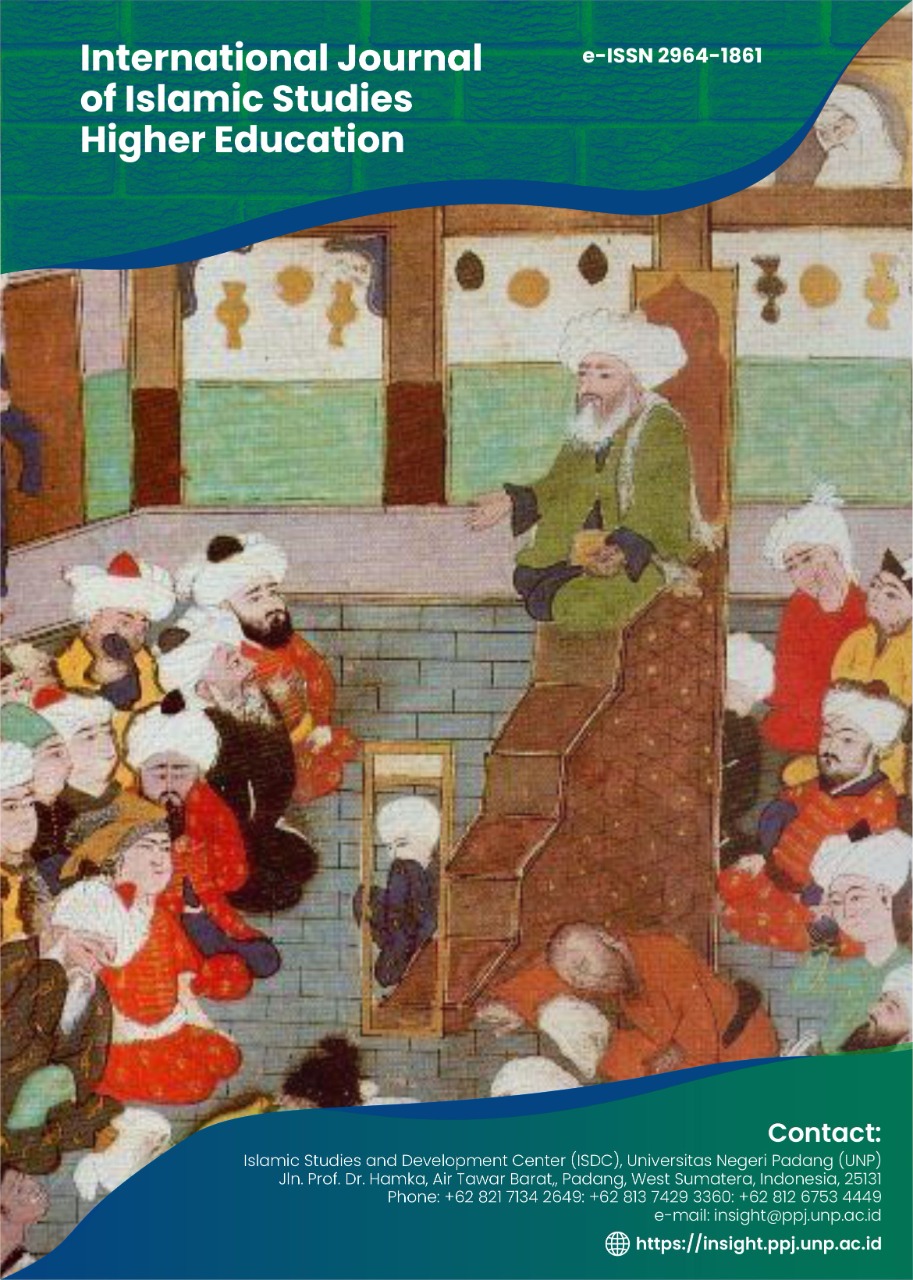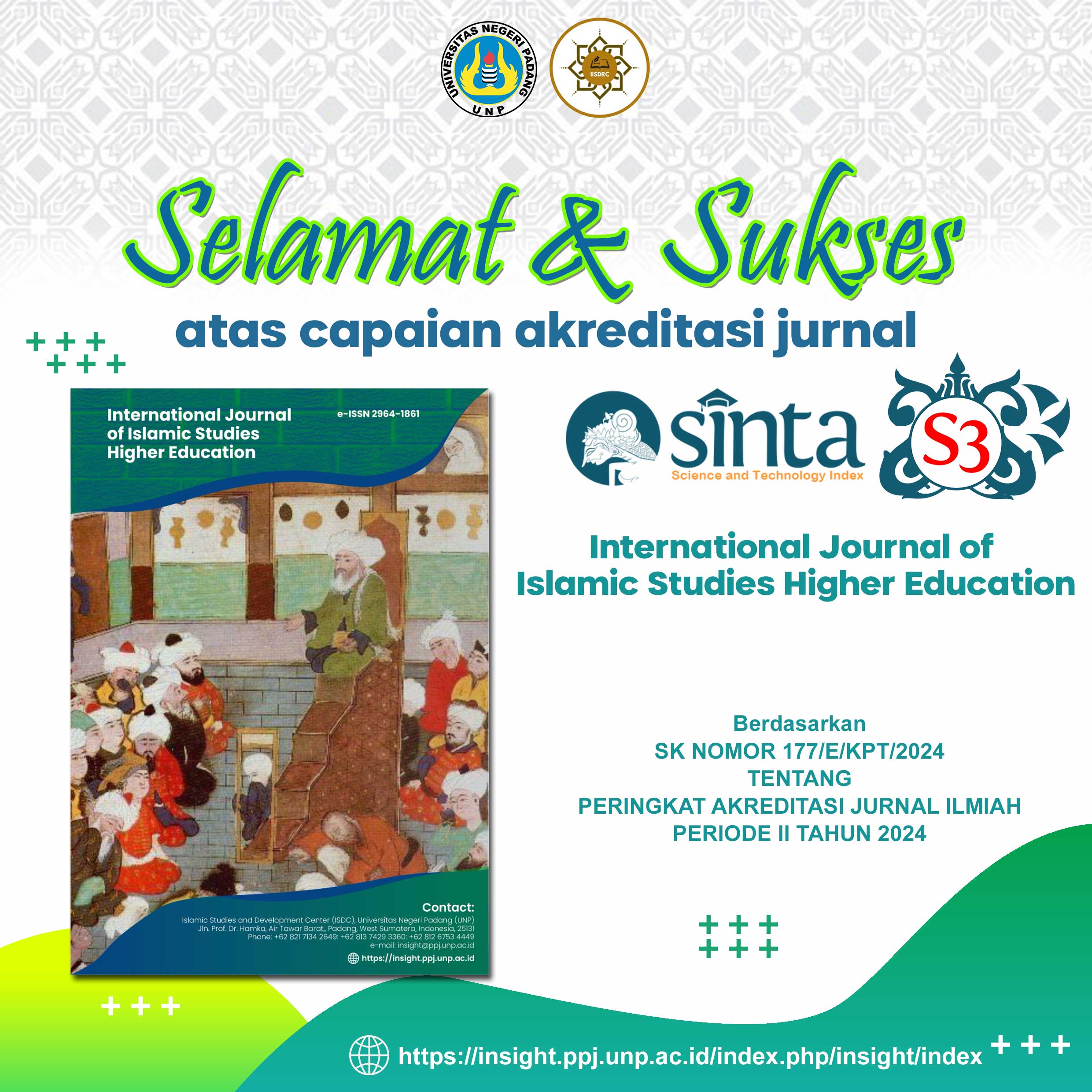Six Motives of Polygamists in Indonesia
DOI:
https://doi.org/10.24036/insight.v3i3.216Keywords:
Motives, polygamists, gender qualityAbstract
One of the important aspects to understand about the issue of polygamy is the motives of the perpetrators, as polygamy has psychological impacts on the wives and children involved. This study aims to explore the motives of polygamists and the effects on their wives and children. A qualitative method with a phenomenological approach was employed, and data were collected through in-depth individual interviews with five informants selected using purposive sampling. The six informants in this study are individuals who have two wives. All data were analyzed thematically using the Miles and Huberman analysis technique. The findings revealed six key motives of polygamists: i) the ability to be fair, ii) having sufficient economic resources, iii) the first wife suffering from a chronic illness, iv) hypersexual behavior, v) incompatibility between the first wife and the family, and vi) raising the dignity of the second wife due to economic hardship. These six motives challenge the negative perceptions of polygamists often held by society, which tend to view their actions as inherently wrong. In reality, these motives are driven by good intentions and align with the values of being a good Muslim.
References
Abd Razak, M. A., Mohd Hashim, I. H., & Drani, S. (2022). How Do First Wives View Polygamy in Terms of Adaptation and Family Cohesiveness? International Journal of Academic Research in Business and Social Sciences, 12(1), 1428–1437. https://doi.org/10.6007/ijarbss/v12-i1/12170
Alase, A. (2017). The Interpretative Phenomenological Analysis (IPA): A Guide to a Good Qualitative Research Approach. International Journal of Education and Literacy Studies, 5(2), 9. https://doi.org/10.7575/aiac.ijels.v.5n.2p.9
Alhazmi, A. A., & Kaufmann, A. (2022). Phenomenological Qualitative Methods Applied to the Analysis of Cross-Cultural Experience in Novel Educational Social Contexts. Frontiers in Psychology, 13, 1495. https://doi.org/10.3389/fpsyg.2022.785134
Andriati, S. L., Sari, M., & Wulandari, W. (2023). Implementasi Perubahan Batas Usia Perkawinan Menurut UU No. 16 Tahun 2019 tentang Perubahan Atas UU No. 1 Tahun 1974 tentang Perkawinan. Binamulia Hukum, 11(1), 59–68. https://doi.org/10.37893/jbh.v11i1.306
Aprilia, M. D. (2018). Motif Poligami Dengan Wanita Pekerja Seks Komersial Eks. Lokalisasi Moroseneng Perspektif Hukum Islam. Al-Hukama’, 7(2), 386–411. https://doi.org/10.15642/alhukama.2017.7.2.386-411
Apriliani, D. R. (2024). Polemik Poligami: Pro dan Kontra Poligami di Indonesia. Journal of Society and Development, 23(1). https://doi.org/10.57032/jsd.v3i1.108
Ardiningrum, A. R., Mesrawati, F., Pradiafta, F. S., Hakim, F., Fajar, G. S., & Angreini, R. (2021). Phenomenological Study of Factors Causing Pre-Marriage Pregnancy among Adolescents. International Journal of Multidisciplinary Research of Higher Education, 4(2), 65–71. https://doi.org/10.24036/ijmurhica.v4i2.82
Asril, Z., Engkizar, Syafril, S., Arifin, Z., & Munawir, K. (2023). Perspective Chapter: A Phenomenological Study of an International Class Program at an Indonesian University. In Higher Education-Reflections from the Field. IntechOpen. https://doi.org/10.5772/intechopen.110325
Cahyani, A. I. (2018). Poligami dalam Perspektif Hukum Islam. Jurnal Al-Qadau: Peradilan Dan Hukum Keluarga Islam, 5(2), 271. https://doi.org/10.24252/al-qadau.v5i2.7108
Cantika, A., Syahrinanda, A., Pridayani, M., Zuriati, H., & Angsisca, N. (2018). The Phenomenon of Pre-Marriage Pregnancy Among Adolescents: An Analysis Regarding the Causes and Solutions. International Journal of Multidisciplinary Research of Higher Education, 1(1), 45–51. https://doi.org/https://doi.org/10.24036/ijmurhica.v1i1.94
Dakhoir, A. (2017). Poligami Dan Power Ekonomi. Jurnal Al-Qardh, 3(1). https://doi.org/10.23971/jaq.v1i1.623
Dalimunthe, N. A., & Milhan, M. (2023). Analisis Yuridis Tentang Pertimbangan Hakim dalam Memberikan Izin Poligami bagi Pegawai Negeri Sipil (PNS) Wanita Sebagai Istri Kedua: As-Syar i: Jurnal Bimbingan & Konseling Keluarga, 5(3), 111–126. https://doi.org/10.47467/as.v5i3.267
Darmawijaya, A. (2020). Dampak Poligami Siri terhadap Kehidupan Keluarga di Desa Cigugur Girang Bandung Barat. Asy-Syari’ah, 21(2), 207–220. https://doi.org/10.15575/as.v21i2.5447
David, P., & Stafford, L. (2015). A Relational Approach to Religion and Spirituality in Marriage. Journal of Family Issues, 36(2), 232–249. https://doi.org/10.1177/0192513X13485922
Engkizar, E., Jaafar, A., Sarianto, D., Ayad, N., Rahman, A., Febriani, A., Oktavia, G., Guspita, R., & Rahman, I. (2024). Analysis of Quran Education Problems in Majority Muslim Countries. International Journal of Islamic Studies Higher Education, 3(1), 65–80. https://doi.org/https://doi.org/10.24036/insight.v3i1.209
Engkizar, E., Jaafar, A., Sarianto, D., Ayad, N., Rahman, A., Febriani, A., Oktavia, G., Guspita, R., & Rahman, I. (2024). Analysis of Quran Education Problems in Majority Muslim Countries. International Journal of Islamic Studies Higher Education, 3(1), 65–80. https://doi.org/https://doi.org/10.24036/insight.v3i1.209
Fuster Guillen, D. E. (2019). Investigación cualitativa: Método fenomenológico hermenéutico. Propósitos y Representaciones, 7(1), 201. https://doi.org/10.20511/pyr2019.v7n1.267
Galieva, G. I. (2021). Polygamy As a Form of Marriage: Based on Sociological Research. KnE Social Sciences, 67–73. https://doi.org/10.18502/kss.v5i2.8397
Gottman, J., & Gottman, J. (2017). The Natural Principles of Love. Journal of Family Theory & Review, 9(1), 7–26. https://doi.org/10.1111/jftr.12182
Green, J., Willis, K., Hughes, E., Small, R., Welch, N., Gibbs, L., & Daly, J. (2007). Generating best evidence from qualitative research: the role of data analysis. Australian and New Zealand Journal of Public Health, 31(6), 545–550. https://doi.org/10.1111/j.1753-6405.2007.00141.x
Herzog, C., Handke, C., & Hitters, E. (2019). Analyzing Talk and Text II: Thematic Analysis. In The Palgrave Handbook of Methods for Media Policy Research (pp. 385–401). Palgrave Macmillan. https://doi.org/10.1007/978-3-030-16065-4_22
Ichsan, M. (2018). Poligami dalam Perspektif Hukum Islam (Kajian Tafsir Muqaranah). JURIS (Jurnal Ilmiah Syariah), 17(2), 151. https://doi.org/10.31958/juris.v17i2.1196
Islam, M. A., & Aldaihani, F. M. F. (2021). Justification for Adopting Qualitative Research Method, Research Approaches, Sampling Strategy, Sample Size, Interview Method, Saturation, and Data Analysis. Journal of International Business and Management, 5(1), 1–11. https://doi.org/10.37227/JIBM-2021-09-1494
Langputeh, S., Andika, S., Ulfah, O., & Agusti, F. A. (2023). A Content Analysis: Values of Islamic Marriage in the Movie of Ayat-Ayat Cinta. International Journal of Multidisciplinary Research of Higher Education, 6(3), 106–114. https://doi.org/10.24036/ijmurhica.v6i3.142
Lew-Starowicz, M., Lewczuk, K., Nowakowska, I., Kraus, S., & Gola, M. (2020). Compulsive Sexual Behavior and Dysregulation of Emotion. Sexual Medicine Reviews, 8(2), 191–205. https://doi.org/10.1016/j.sxmr.2019.10.003
Madeli, M. H., Yanti, I., & Sulaeman, S. (2022). Analisis Pertimbangan Hakim Pengadilan Agama Kelas 1 A Kota Jambi dalam Putusan No. 642/Pdt.G/2020/PA.Jmb tentang Perceraian Sebab Hypersex. NALAR FIQH: Jurnal Hukum Islam, 13(1), 51–62. https://doi.org/10.30631/nf.v13i1.1288
Marzuki, I. (2019). Politik Hukum Poligami (Studi terhadap Peraturan Perundang-Undangan di Negara-Negara Muslim). Al-Manahij: Jurnal Kajian Hukum Islam, 13(1), 141–157. https://doi.org/10.24090/mnh.v13i1.1799
Masri, E. (2019). Poligami dalam Perspektif Undang-Undang Nomor I Tahun 1974 tentang Perkawinan dan Kompilasi Hukum Islam (KHI). KRTHA BHAYANGKARA, 13(2), 223–241. https://doi.org/10.31599/krtha.v13i2.7
Mengistu, N., Shumye, S., Tesfaye, T. S., Haile, S., Bayisa, Y., Yimer, S., Tadesse, M., Markos, T., Madoro, D., Assefa, D. G., Molla, W., Abebe, L., Molla, A., Wudneh, A., & Duko, B. (2022). Stressful life experience of the first married women in polygamous families in Gedeo zone, South Ethiopia: a qualitative study, 2021. BMC Psychology, 10(1), 40. https://doi.org/10.1186/s40359-022-00753-4
Miski, M., Aulia, M., Jannah, R., & Laily, R. N. (2022). Polygamy Mentoring in Indonesia: Al-Qur’an, Hadith and Dominant Discourse Resistance. Millati: Journal of Islamic Studies and Humanities, 7(1), 15–32. https://doi.org/10.18326/mlt.v7i1.7036
Mohanty, S., & Verma, A. (2013). Qualitative Analysis. In Practical Clinical Biochemistry (pp. 4–4). Jaypee Brothers Medical Publishers (P) Ltd. https://doi.org/10.5005/jp/books/12012_2
Mulder, M. B. (2017). Reproductive Decisions. In Evolutionary Ecology and Human Behavior (pp. 339–374). Routledge. https://doi.org/10.4324/9780203792704-11
Murphy, Y. (2016). The marriage equality referendum 2015. Irish Political Studies, 31(2), 315–330. https://doi.org/10.1080/07907184.2016.1158162
Muzzammil, S., Affan, M., HS, M. A., & Masturiyah, M. (2021). Motif, Konstruksi, dan Keadilan Semu dalam Praktik Poligami Kiai Pesantren di Madura. Jurnal SMART (Studi Masyarakat, Religi, Dan Tradisi), 7(01), 129–142. https://doi.org/10.18784/smart.v7i01.1207
Naseer, S., Farooq, S., & Malik, F. (2021). Causes and Consequences of Polygamy: An Understanding of Coping Strategies by Co-Wives in Polygamous Marriage. Asean Journal of Psychiatry, 22(9), 1–10. https://doi.org/10.54615/2231-7805.47221
Nuryana, A., Pawito, P., & Utari, P. (2019). Pengantar Metode Penelitian kepada Suatu Pengertian yang Mendalam Mengenai Konsep Fenomenologi. ENSAINS JOURNAL, 2(1), 19. https://doi.org/10.31848/ensains.v2i1.148
Peoples, K., Zazzarino, A., Thompson, J., Riley, P., Shelton, D., Fisher, R., Kirkland, V., & Richardson-O’Neill, B. (2019). The Unfaithful Male in Monogamous and Non-Monogamous Marriage: A Phenomenological Case Study. Sexual Addiction & Compulsivity, 26(1–2), 137–163. https://doi.org/10.1080/10720162.2019.1608880
Rahmanian, P., Munawar, K., Mukhtar, F., & Choudhry, F. R. (2021). Prevalence of mental health problems in women in polygamous versus monogamous marriages: a systematic review and meta-analysis. Archives of Women’s Mental Health, 24(3), 339–351. https://doi.org/10.1007/s00737-020-01070-8
Rettenberger, M., Klein, V., & Briken, P. (2016). The Relationship Between Hypersexual Behavior, Sexual Excitation, Sexual Inhibition, and Personality Traits. Archives of Sexual Behavior, 45(1), 219–233. https://doi.org/10.1007/s10508-014-0399-7
Ridwan, M. S., Abdullah, W., & Idham, I. (2024). Public Perception of Polygamy in Makassar, Indonesia: Cultural Perspective and Islamic Law. Samarah: Jurnal Hukum Keluarga Dan Hukum Islam, 8(1), 20. https://doi.org/10.22373/sjhk.v8i1.15419
Rini, E. F. S., & Aldila, F. T. (2023). Practicum Activity: Analysis of Science Process Skills and Students’ Critical Thinking Skills. Integrated Science Education Journal, 4(2), 54–61. https://doi.org/10.37251/isej.v4i2.322
Rohmah, N. F., & Budihardjo, B. (2021). Praktik Pernikahan Poligami dalam Pandangan Hukum Islam dan Hukum Negara. Profetika: Jurnal Studi Islam, 22(2), 237–257. https://doi.org/10.23917/profetika.v22i2.16669
Saldaña, J. (2020). Qualitative data analysis strategies. In The Oxford Handbook of Qualitative Research (pp. 877–912). Edward Elgar Publishing. https://doi.org/10.1093/oxfordhb/9780190847388.013.33
Salsabiela, R., & Prananda, R. R. (2023). Pembatalan Perkawinan Dalam Kasus Poligami Tidak Tercatat Yang Perkawinannya Telah Putus Akibat Kematian. AL-MANHAJ: Jurnal Hukum Dan Pranata Sosial Islam, 5(2), 1505–1522. https://doi.org/10.37680/almanhaj.v5i2.3387
Sam’ani, S., Rokhmadi, R., Amin, N., Zaini, A., & Sarib, S. (2023). Pragmatism of Polygamous Family In Muslim Society: Beyond Islamic Law. Samarah: Jurnal Hukum Keluarga Dan Hukum Islam, 7(1), 321. https://doi.org/10.22373/sjhk.v7i1.15874
Santoso, D., & Nasrudin, M. (2021). Polygamy in Indonesia and its Relevance to the Protection of Women and Children in the Perspective of Islamic Law Philosophy. AKADEMIKA: Jurnal Pemikiran Islam, 26(1), 121. https://doi.org/10.32332/akademika.v26i1.2406
Sari, V. P., & Kartini, F. I. (2024). Aspek Spiritual Pada Pasien Dengan Penyakit Kronis Di Rumah Sakit Amelia Kecamatan Pare Kabupaten Kediri. Khatulistiwa Nursing Journal, 6(1). https://doi.org/10.53399/knj.v6i1.245
Satrianis, S., Deswana, D., Hayati, S. N., & Aziz, A. (2021). The Phenomena of Pregnancy Out of Marriage Among Students and the Solution. International Journal of Multidisciplinary Research of Higher Education, 4(2), 59–64. https://doi.org/10.24036/ijmurhica.v4i2.110
Sayyidah, S., Rahman, I. K., & Ramly, A. T. (2021). Konsep Keadilan Dalam Poligami Menurut Agama Islam. Diversity: Jurnal Ilmiah Pascasarjana, 1(1). https://doi.org/10.32832/djip-uika.v1i1.4360
Scanlon, M., Powell, F., Leahy, P., Jenkinson, H., & Byrne, O. (2019). ‘No one in our family ever went to college’: Parents’ orientations towards their children’s post-secondary education and future occupations. International Journal of Educational Research, 93, 13–22. https://doi.org/10.1016/j.ijer.2018.09.005
Sentosa, A. R., & Apriliani, N. (2020). Pemerolehan Bahasa Pada Anak Usia Dini (Kajian Psikolinguistik). Seminar Nasional Pendidikan, 1–7. https://doi.org/https://prosiding.unma.ac.id/index.php/semnasfkip/article/view/293
Septiandani, D., & Astanti, D. I. (2021). Konsekuensi Hukum bagi Suami yang Melaksanakan Poligami yang Melanggar Aturan Hukum Positif Indonesia dan Hukum Islam. JURNAL USM LAW REVIEW, 4(2), 795. https://doi.org/10.26623/julr.v4i2.4314
Sugitanata, A., Karimullah, S. S., & Hasan, F. (2024). Dinamika dalam Praktik Pernikahan: Tawaran untuk Mengurangi Prevalensi Poligami di Era Kontemporer. AT-THARIQ: Jurnal Studi Islam Dan Budaya, 4(01). https://doi.org/10.57210/trq.v4i01.284
Supraptiningsih, U., Rahmawati, T., Fauzi, M. M., & Zainab, L. (2023). G Gender Analysis: of Polygamy Permit Based on the Reason of Benefit. Nurani: Jurnal Kajian Syari’ah Dan Masyarakat, 23(2), 365–376. https://doi.org/10.19109/nurani.v23i2.16937
Sururie, R. W. (2017). Polemik di Seputar Hukum Isbat Nikah dalam Sistem Hukum Perkawinan Indonesia. Al-Manahij: Jurnal Kajian Hukum Islam, 11(2), 233–246. https://doi.org/10.24090/mnh.v11i2.1299
Surya, A., Jaafar, A., Ediz, M. H., & Yusrial, Y. (2024). The Effect of Kafa’ah on Marriage from the Perspective of Mashlahah: An Analysis of the Maliki Madhhab. Jurnal Elsyakhshi, 2(1), 33–41. https://doi.org/10.69637/jelsy.v2i1.60
Syafrudin, S. (2023). Manajemen Konflik Keluarga Poligami di Desa Simeulue Barat. Familia: Jurnal Hukum Keluarga, 4(2), 146–159. https://doi.org/10.24239/familia.v4i2.123
Taylor, L. (2013). The Case as Space. Qualitative Inquiry, 19(10), 807–817. https://doi.org/10.1177/1077800413503799
Wahyono, D. (2022). Patriarchal Oppression on Women in Pakistan Reflected in Malala Yousefzai and Christina Lamb’S I Am Malala. Anaphora: Journal of Language, Literary and Cultural Studies, 4(2), 170–188. https://doi.org/10.30996/anaphora.v4i2.6075
Wirastri, T. D., & van Huis, S. C. (2021). The second wife: Ambivalences towards state regulation of polygamy in Indonesia. The Journal of Legal Pluralism and Unofficial Law, 53(2), 246–268. https://doi.org/10.1080/07329113.2021.1912579
Yusnia, D. (2018). Analysis The Ability of Students Problem-Solving on Counting Operations of Algebra Form. MUST: Journal of Mathematics Education, Science and Technology, 3(1), 1. https://doi.org/10.30651/must.v3i1.1017
Downloads
Published
How to Cite
Issue
Section
License
Copyright (c) 2025 M. Hidayat Ediz, Hanivatul Khairat, Dasrizal Dasrizal, Deliza Nur Hasnah, Datres Datres, Aulia Rahmat, Widia Sulastri, Zulfadli Zulfadli

This work is licensed under a Creative Commons Attribution-ShareAlike 4.0 International License.











